The early history of this quarry seems to be a bit of a mystery. It was certainly operating in 1876, as Littlebury’s Directory of that year refers to good quality limestone being found in the area in great quantities and adds that “the quarries at Whitman’s Hill are well known”. Thomas Morgan is listed here as a “farmer, contractor, stone and lime merchant, Cowleigh Gate Farm, Whitman’s Hill”. Could he have been the owner or manager of this quarry? Or could it perhaps have been Jacob Gill who is listed as a “quarry proprietor”?
Evidence From William Jones' Map
Looking further back to a Directory of 1851, there is no mention in that year of any stonemason or quarryman. However, in 1855, William Jones, in the list accompanying his map of Cradley, has the names of at least a dozen stonemasons or quarrymen and one lime burner, William Smart of Loddits Green. This no doubt shows the greatly increased need for stone in the developing towns and industrial areas, for although the Romans were probably the first quarriers in Britain (Latin “quadraria” or places where squared stones were cut), quarrying was not done on a large scale until the eighteenth and nineteenth centuries.
A 1904 map of this area shows at least thirty quarries in Cradley and Storridge, some with sandstone and limestone of good commercial value and some of sand and gravel. This is indicated by placenames such as Grittlesend and Sandpitts. A local worker in lime production in 1915 was Thomas Williams, the Storridge church sexton, whose grave can be seen in the churchyard. His name was in Steven’s Annual of that year.
Lime Production
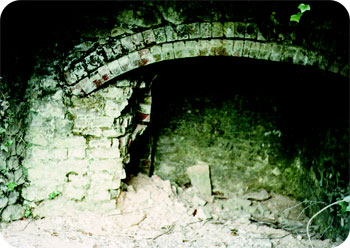
Work in these quarries in the early days would have been done by hand, with shovels, picks, sledgehammers and crowbars, according to Mrs. Jean Horne, whose father and grandfather both worked at Whitman’s Hill. As the title of the company, “Whiteman’s Hill Lime Products”, indicated at that time, the work was to produce lime, and three limekilns were in or near the quarry itself. Later, in 1965, when the emphasis was on stone production, the title was altered to “Whiteman’s Hill Quarry Ltd”.
Lime had many important uses. It was used in agriculture, to spread on fields and remedy blight on hops and turnips. It was also used to limewash houses and farm buildings and it was added to clay to make the “daub” which was used with wattle to fill between beams. Other uses included tanning hides and making paper. Cradley parish records show that the Overseer of the Poor in Cradley in 1761, Mr. Woodyatt, “paid for lime to repair John Lewis’ house”.
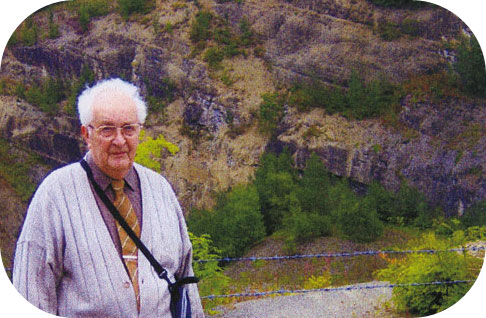
During a visit to the quarry in 2006, Mr. Roy Lockyer, whose father leased the quarry from 1926 to 1952, described lime-burning in those days:
“Two kilns were side by side with a manual crane and the material was brought up using trucks on a set of rails pulled by a horse. There was stabling there then. The firing was a specialist job and the kilns were like wells with a circular chamber about 20 feet deep. There was a wood fire in the bottom, then coke, then a layer of limestone, all of which was burnt through from the bottom of the kiln with the fire rising upwards. The lime was the best you could get in the area, using a blue stone that turned a shaly white after burning and something between five and ten tonnes would be produced each week.”
A Woman's Work With Stone
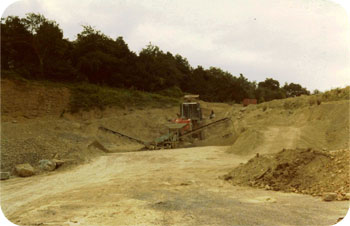
Later, when stone was the main product, Mrs. Jean Horne was the only woman working at the quarry and she sat in a little hut with a stove in it and worked the weighbridge. The lorries would go on to the weighing plate outside and she would record the weight inside where there was a big bar with weights on.She says she was often busy from 7.30 in the morning until 5 o’clock, as she had to deal by radio with the men in the quarry itself, take the orders and ensure that as many lorries as possible left with full loads. The work had become mechanised by then with a crushing plant, screening plant, dumptruck and a wheeled loader.
Mr. John Milner, Chairman of Huntsman’s Quarries today, described the quarrying operation from the early 1970s. The site was usually operated by four people. One man operated the loading bucket that collected rock from the face and put it in the dumptruck which conveyed the rock to the crushing plant. The next man tipped the rock into the hopper, then the crusher and then the screening plant, where it was separated into various grades.
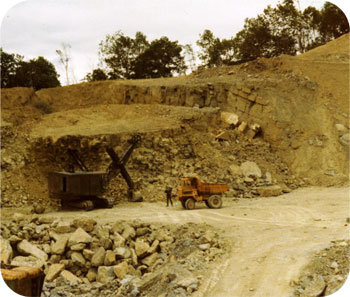
He then drove the dumptruck back to collect more material. The third man drove the wheeled loader, a four wheel drive tractor with a bucket which loaded the road lorries. Finally the material went to the weighbridge where the fourth person, Mrs. Jean Horne, recorded and ticketed the crushed rock before the lorries left for their destinations. Demand was high for the stone then, because of the growth of Malvern and Worcester. This aggregate or roadstone was used mainly as infill and foundations in building roads and houses: “for putting under homes, factories, agricultural buildings and for general construction purposes, probably within a fifteen to twenty mile radius of the quarry. Throughout the 1970s and 1980s production would have been about 50,000 to 70,000 tonnes per year and in total over one million tonnes must have been removed.”
Mr. Ted Stewart, who worked at the quarry in the late 1950s driving a loader truck, remembers taking many loads of aggregate down to Tewkesbury for the new industrial estate there. He also fetched magnesium rock supplies from the Forest of Dean to mix with the lime at Whitman’s Hill. At this time a “crusher” and a “mill” were used to process the lime, for which there was still a considerable demand. Mr. Clem Williams was the foreman during his time there and was the explosives expert.
Danger At The Quarry

Both Mr. and Mrs. Fred Beard and Mrs. Jean Horne remember blasting being done at the quarry and the problem of pieces of stone flying onto nearby houses and cracking tiles on the roofs! One day, Mr. Albert Camden and his colleagues drilled holes three feet deep in a bank, inserted charges and “blew” the bank just before lunch. When they returned they found the entire bank had fallen and covered the area where they had just been working! Mr. Camden recalls: “We missed death by about two minutes, none of us could have survived that downfall”.
Final Days
Quarrying stopped in 1988, mainly because the site had been worked out as far as was possible. All the machinery was removed, the site was restored and made safe and trees were planted. The lease reverted to the landlords, the Trustees of Madresfield Estate, in 1997. Records show that earlier names of leaseholders included Lockyer, Tansell, Randall and Booth, and Hanks.
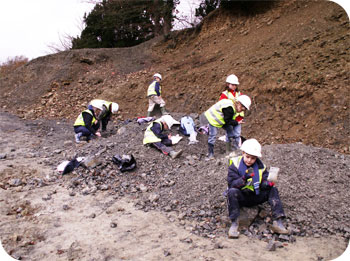 Now, in 2007, the Herefordshire and
Worcestershire Earth Heritage Trust has a
ten year lease from the Madresfield Estate
and run the Whitman’s Hill Geodiversity
Discovery Venture. This project has been
funded by the Aggregates Levy Sustainability
Fund and involves research into the geology,
natural history and local heritage of the
site, the latter two areas of research being
undertaken by the Woolhope Naturalists’
Field Club and Cradley Heritage Group
respectively. People are now able to have
guided visits to the quarry to see its ancient
rocks and fossils.
Now, in 2007, the Herefordshire and
Worcestershire Earth Heritage Trust has a
ten year lease from the Madresfield Estate
and run the Whitman’s Hill Geodiversity
Discovery Venture. This project has been
funded by the Aggregates Levy Sustainability
Fund and involves research into the geology,
natural history and local heritage of the
site, the latter two areas of research being
undertaken by the Woolhope Naturalists’
Field Club and Cradley Heritage Group
respectively. People are now able to have
guided visits to the quarry to see its ancient
rocks and fossils.
This important site, already of interest to geologists, is now becoming an educational and community facility for both adults and children.

